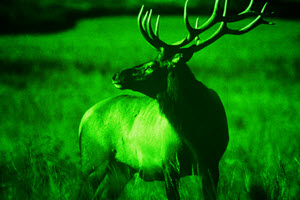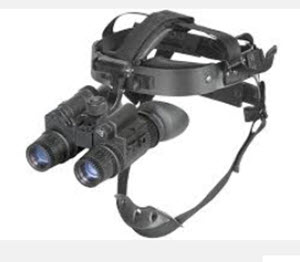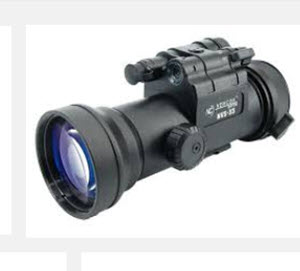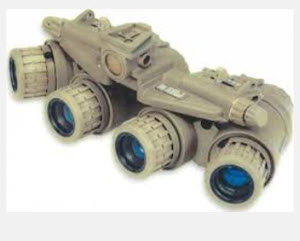Night vision devices are commonly associated with the military and law enforcement agencies, but they are available for consumer use as well. Before you purchase and use one, it is important that you check up on applicable laws and regulations. There are parts of the world were night vision devices required a permit, especially if it is the type of night vision device that can be mounted on a firearm.
Night vision devices are sometimes marketed as night optical devices or night observation devices (NOD).
 Set up
Set up
A night vision device will typically contain an image intensifier tube, and if it is an active night vision device there will also be some type of illuminator (typically infrared). Examples of optical components that can improve the night vision device are telescopic lenses, sacrificial lenses and mirrors. For practical reasons, commercially available night vision devices tend to be enclosed in a water resistant housing since most buyers will want to use the night vision device outdoors.
Development and features
The driving force behind improved night vision technology has often been military needs. For us consumers, many of the technologies that are available to us today once originated in army research facilities. Night vision devices were used by both sides in World War II, and the technology took a great leap forward to accommodate for new needs during the Vietnam War.
However, one of the pioneers in the field of night vision devices was actually trying to create something for civilian use. Dr Vladimir K. Zworykin developed an early night vision device while working for the Radio Corporation of America. While functional, this device was also big and expensive, and it failed to become a commercial success.
 In Germany, AEG experimented with night vision devices for the army as early as the mid-1930s and they were ready for use by the start of World War II. The Russian PAU-2 was field tested in 1942, and in the following year tests commenced for infrared night-vision (Nacht Jager) devices and telescopic rangefinders mounted on Panther tanks. By the end of WWII, Panther tanks with night vision devices had been used on both the Eastern and the Western fronts. Additionally, German infantrymen mounted a portable night vision device known as the Vampir on their Sturmgewehr 44 assault rifles.
In Germany, AEG experimented with night vision devices for the army as early as the mid-1930s and they were ready for use by the start of World War II. The Russian PAU-2 was field tested in 1942, and in the following year tests commenced for infrared night-vision (Nacht Jager) devices and telescopic rangefinders mounted on Panther tanks. By the end of WWII, Panther tanks with night vision devices had been used on both the Eastern and the Western fronts. Additionally, German infantrymen mounted a portable night vision device known as the Vampir on their Sturmgewehr 44 assault rifles.
As mentioned above, the U.S. Army also utilized night vision devices during WWII. The M1 and M3 infrared night sighting devices (“sniperscopes”) developed for the U.S. Army during WWII were later also used by the U.S. snipers in the Korean War. Both M1 and M2 are active rather than passive devices, since they (in addition to using an image intensifier) emitt infrared light to illuminate targets.
USA: GEN I
During the Vietnam War, the U.S. Army started using night vision devices that relied on ambient light instead of having their own infrared light source. A GEN I night vision device will typically need moonlight or better to work well. Examples of GEN I night vision devices are the PNV-57E Tanker Goggles and the PAS 6 Varo Metascope.
USA: GEN II
GEN II night vision devices have no light source, but will still work even during moonless nights thanks to an advanced image-intensifier tube that utilizes micro-channel plate (MCP) with an S-25 photo-cathode. Examples of GEN II night vision devices are the AN/PVS-4, AN/PVS-5 and PNV-10T.
GEN II+ devices have even better optics and intensifier tube.
USA: GEN III
These night vision devises use a photo-cathode made with gallium aersenide, and this translates into a better image resolution. An ion barrier has been added to the MCP to make it last longer, but this is a bit of a doubleedged sword since that also means that fewer electrons can penetrate. You can expect a fairly big halo-effect around bright spots / light sources. Examples of GEN III devices are AN/PVS-7, AN/PNVS-14 and PN-21K.
USA: After GEN III

NVS-22
The modern GEN III OMNI VI – VII night vision devices are sometimes unofficially referred to as GEN IV due to them being significantly different from the earlier GEN III devices. One notable difference (although not present on all devices) is the instantaneous adaption to changing light conditions, a feature made possible by an automatic gated power supply system for the photo-cathode voltage.
The ion barrier that is causing problems on older-style GEN III devices has been made thinner or is completely absent on these later devises. This means a shorter lifespan for the tube, but improves the capacity of the device.
Examples of “GEN IV” devices are AN/PVS-22 and NVS-22.
Auto-gating (ATG)
Auto-gating (ATG) is utilized to improve the night vision device’s ability to keep optimal resolution and contrast in rapidly changing conditions. Today, it is a common feature in night vision goggles devices intended for urban use or for flying at low altitudes, or for other environments where the light can rapidly change from low to high.
For weapons that create a flame burst during shooting, a night vision sight with ATG will reduce temporary “blindness”.
Counter-sniper night sights
Counter-sniper night sights contain a laser diode that will emit laser pulses to detec reflections from the focal elements of enemy optical systems. Once detected, their range can be estimated.
Examples of counter-sniper night sights are the Russian 1PN106 (for the SVD sniper rifle), 1PN121 (for the ASVK large caliber sniper rifle) and the 1PN119 (for the PKMN light machine gun).
CORE
The Ceramic Optical Ruggedized Engine (CORE) produces higher performance GEN I tubes with less photo sensitivity and edge distortion. The technology was introduced to the consumer market in the early 2010s. Instead of the traditional glass plate, a plate made from ceramic and metal alloys is used. At the time of writing, resolutions up to 60 lp/mm are available.
Panoramic night vision goggles (PNVG)
 Panoramic night vision goggles (PNVG) increases the wearer’s field of view as compared to traditional night vision goggles. The U.S. Air Force are currently using PNVGs where the field of vision is 95 degrees. Instead of the typical configuration (2 x 18 mm image intensifier tubes), these goggles have 4 x 16 mm image intensifier tubes. Panoramic night vision goggles are employed in the A-10 Thunderbolt II, the MC-130 Combat Talon and the AC-130U Spooky.
Panoramic night vision goggles (PNVG) increases the wearer’s field of view as compared to traditional night vision goggles. The U.S. Air Force are currently using PNVGs where the field of vision is 95 degrees. Instead of the typical configuration (2 x 18 mm image intensifier tubes), these goggles have 4 x 16 mm image intensifier tubes. Panoramic night vision goggles are employed in the A-10 Thunderbolt II, the MC-130 Combat Talon and the AC-130U Spooky.
NOD with thermal imaging
At the time of writing, a lot of research is being carried out in an effort to enhance classic night vision devises (image intensification devises) by adding thermal imaging. The AN/PSQ-20 has already been released.
Night vision contact lens
An experimental night vision contact lens has been developed by researchers at the University of Michigan. The lens consists of two layers of glass, holding a thing strip of graphene between them. The graphene reacts to photos and this makes dark images look brighter.
At the time of writing, the lens isn’t good enough to actually be useful in the field, but its capacity is expected to be improved soon. The percentage of light pickup needs to be increased, since it is currently below 3%.
This article was last updated on: April 25, 2016

